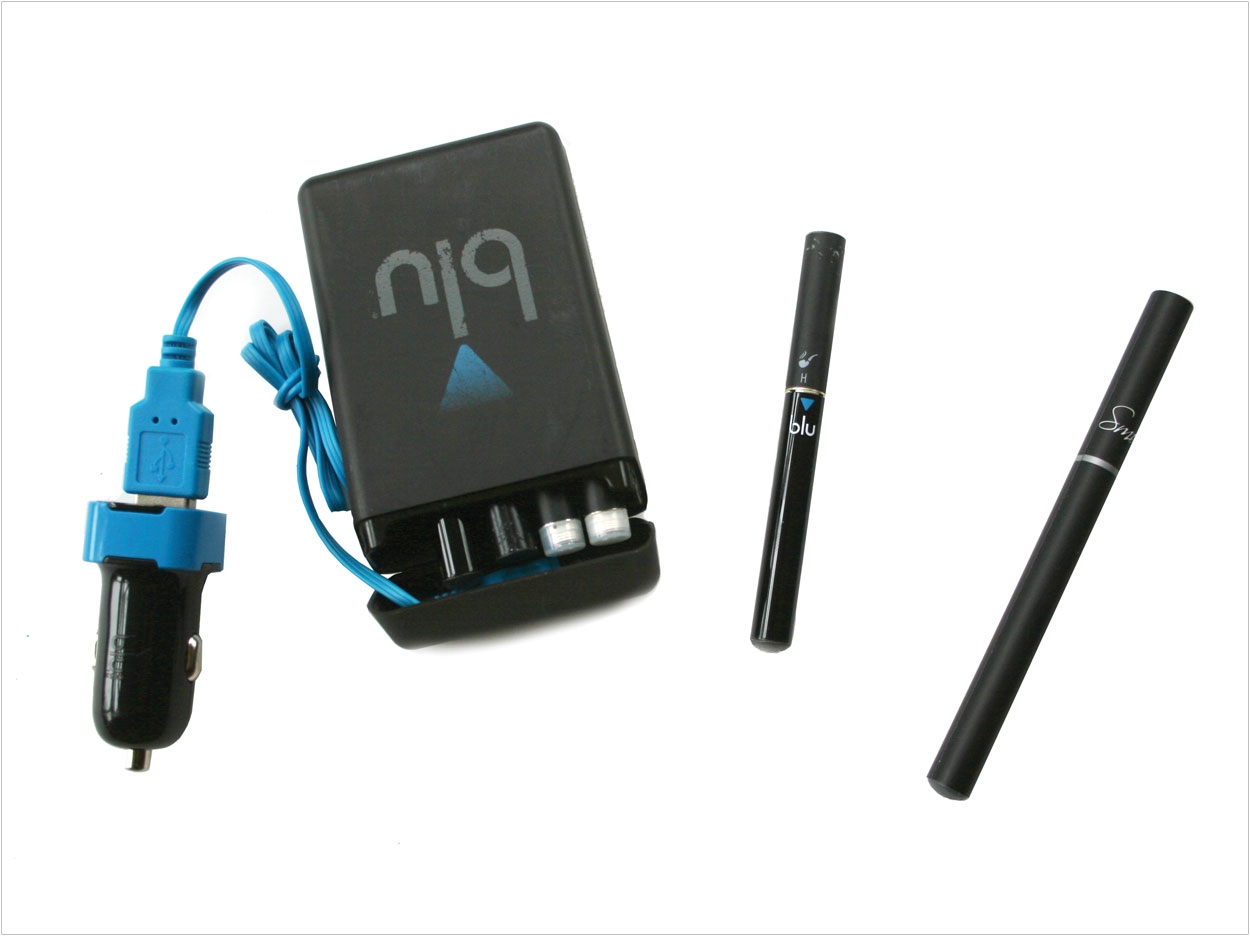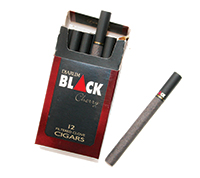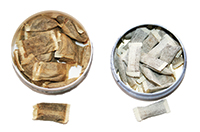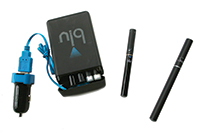
DECLINE OF CIGARETTE USE AND THE RISE OF NEW PRODUCTS
Since the 1964 Surgeon General’s Report on Smoking and Health linked smoking to increased risks for cardiovascular, respiratory diseases and cancer, overall smoking prevalence of the adult population declined from 42% (1964) to 17.8% (2012).1 In response to the decreasing number of adult cigarette smokers, the tobacco manufacturers were successful in promoting new tobacco products. For example, cigar and pipe smoking became very popular in 1990s due partly to increases in taxation of cigarettes.2 The tobacco industry has been trying to attract young nonusers and expand their market by introducing “healthier,” “mild,” and “natural” tobacco products, such as dissolvable tobacco products, introduced in 2000s. A growing number of adolescents and young adults are trying exotic forms of tobacco such as shisha, bidis, kreteks, and snus. After being successful in China and Europe, electronic cigarettes have become popular in the American market since their introduction in 2004. Their sales have exceeded the $1 billion dollar mark.3 Regulatory agencies, such as the US FDA, are slow in implementing regulations on these products. The dental professional should be educated about these alternative tobacco and nicotine products to be prepared to properly counsel patients. The goals are to identify users of these products among patients by asking specific questions and inform them about tobacco and chemical content of these products, systemic and local effects, and their potential for nicotine addiction or harm reduction.
Exotic Imported Products
According to the American Cancer Society, many forms of flavored tobacco (such as clove cigarettes, bidis, and shisha) have become popular in recent years.4 Young people might perceive clove cigarettes from Indonesia and bidis from India as “herbal,” “natural,” or safe. Clove cigarettes, also known as kreteks, contain about 60% to 70% of tobacco and 30% to 40% of ground cloves, clove oil, and other additives (Figure 1). Smoke of kreteks can be less irritating because eugenol in the smoke anesthetizes the airways, and smokers inhale deeper.
 |
 |
| Figure 1. Clove cigarettes are sold as small cigars to avoid cigarettes taxes. | Figure 2. Bidis are hand-rolled cigarettes from India. |
Bidi is tobacco hand-rolled in a nonporous tendu or temburni leaf (Figure 2). These come in different flavors like vanilla, mango, wild cherry, and chocolate. Bidis are cheaper than a pack of traditional cigarettes and have become popular among younger people, partly due to their resemblance to cannabis joints. These cigarettes do not have a filter and the outer nonporous cover does not allow smoke to be diluted with outside air, thus increasing amount of tar and carcinogens inhaled by a smoker. According to the US Centers for Disease Control and Prevention (CDC), bidi smoke contains 3 to 5 times the amount of nicotine compared to a regular cigarette and places users at risk for nicotine addiction.5 Smoking bidis increases risks for developing oral and pharyngeal cancers. In 2011, 1.7% of US middle school students and 2.0% of high school students were current bidi smokers. The percentage of students in the United States who are current kretek smokers is at 1.1% of all middle school students and 1.7% of all high school students.5 Young people should be educated that both kreteks and bidis contain tobacco and deliver more nicotine, tar, and carbon monoxide than regular cigarettes and carry similar health risks.
Shisha is used in smoking hookahs, or waterpipes (Figure 3). An increasing number of hookah cafés are located near college campuses in the United States and Europe, and smoking hookah has become popular among both male and female high school and college students (ages 15 to 20).6 According to 2012 National Youth Tobacco Survey, while cigarettes and cigars remain the most commonly used forms of tobacco, a number of middle and high school students who are hookah users is on the rise—from 4.1% in 2011 to 5.4% in 2012.7 When smoking hookah, shisha tobacco is roasted, smoke passes through water, and is drawn through a rubber hose to a mouthpiece. Many users believe the water filters out the toxins contained within the shisha tobacco, and therefore, hookah smoke is less harmful to the throat and respiratory tract than cigarette smoke.8 The water does not filter out the toxins, but rather moisturizes the smoke, and hookah smokers may inhale the moisturized, less irritating smoke deeper for a prolonged period of time. One session of smoking hookah usually lasts an hour with smokers inhaling 100 times more smoke than those who smoke a traditional cigarette.6 Lung and oral cancer, as well as periodontal disease, have been linked to hookah smoking. Preliminary studies establishing these links were conducted in the Middle East and Asia and generally involved small samples.8,9 Recent studies found that significant (73 times greater than cigarette smoking) nicotine intake and carcinogen exposure during hookah smoking can lead to increased risk of cancer and other chronic diseases.10 The high level of nicotine can lead to tobacco addiction—both physical and psychological.11 Even smoking herbal (nontobacco) hookah is not harmless—the users are exposed to similar or greater amount of toxic by-products as produced by smoking tobacco shisha.12 Smoking herbal hookah is not restricted by age, as it doesn’t contain any tobacco. Hookah smoking also presents the unique risk of spreading infectious diseases such as tuberculosis and hepatitis because hookah is passed from one smoker to another without proper disinfection of mouthpieces and hoses between sessions.
New Smokeless Tobacco Products
Use of smokeless tobacco products present less risks for cardiovascular and lung diseases since there is no burning of tobacco, no tar, and no carbon monoxide exposure. However, users of these products are still exposed to nitrosamines (carcinogens) and nicotine that supports addiction. Dissolvable tobacco products such as tobacco orbs, sticks, and strips were introduced in limited markets around 2009. Dissolvable products could be used in smoke-free areas and many smokers started using them in conjunction with cigarette smoking, thus maintaining the habit and increasing nicotine intake. The discreet size of the products allowed young users to bring them to schools. Fortunately, these products were not very successful commercially because of the low level of nicotine content.
 |
| Figure 3. Hookah smoking is permitted inside certain cafés and restaurants. |
 |
| Figure 4. Swedish snus (left) and American snus (right). |
 |
| Figure 5. E-cigarettes can be rechargeable (left and center) or disposable (right). |
Snus, a Swedish smokeless tobacco product, stands out as a potential harm reduction product (Figure 4). Sweden has one of the lowest rates (16% in 2002) of cigarette smoking with the lowest smoking-related deaths and lung cancer rates among men; these lower death and cancer rates are attributed to the popularity of snus among adult males.13 Swedish snus has about 50% moisture content and can deliver the same amount of nicotine as one cigarette, which is attractive to those smokers who have difficulty quitting tobacco. Unlike American smokeless tobacco, snus is placed between the cheek and upper lip. It can be used for about 30 minutes and the nicotine is absorbed through the oral mucosa without chewing. Snus is not harmless; its use can cause dental caries, irreversible oral lesions, and gingival recession in the area of placement. However, snus contains significantly lower number of nitrosamines and other carcinogenic substances than snuff due to a different processing of tobacco used in Swedish product.13,14 While snus was not associated with oral or lung cancer, a study published in Lancet15 in 2007 found that the risk for pancreatic cancer in snus users was nearly double compared with those who had never smoked. However, the prevalence of pancreatic cancer is not higher in Sweden, where snus is widely used. Two epidemiology studies that analyzed snus use and the risk of pancreatic cancer in Scandinavian men were later criticized for design and methodological limitations, and results from these 2 studies were deemed inconsistent.15 In a large-scale study conducted in Australia, lifelong users of snus had a life expectancy comparable to those who quit tobacco all together.16
Snus, considered a gateway from cigarette smoking in Sweden, has resulted in substantial health benefits for the population. Using snus to assist in quitting smoking has been proven to increase the success rate by 50%.13 Snus is still highly addictive, but it is widely held to be significantly less harmful than cigarette smoking.13 American tobacco manufacturers introduced a few snus products, but they do not mimic Swedish snus and, in addition, these products do not go through the same tobacco pasteurization process. Further studies should investigate the risks and potential of snus as a harm reduction product for those people who cannot quit tobacco.16
E-Cigarettes (ENDS)
Electronic cigarettes (e-cigarettes, or electronic nicotine delivery systems [ENDS]) are nicotine delivery devices that look like cigarettes or cigars (Figure 5). Adult smokers often start using ENDS (also called vaping [term derived from vapors]) to decrease craving and potentially quit tobacco.17 Traditional nicotine replacement therapy products (patches, gum, etc) do not deliver nicotine in the same way as cigarettes, so many smokers continue to crave cigarettes. They also miss the “ritual” of smoking, making it difficult to stay tobacco-free. ENDS have the potential to address physical and mental aspects of tobacco addiction by delivering nicotine to curb the cravings and maintaining the ritual of “smoking,” thus satisfying the psychological dependence.
The use of e-cigarettes among young adults and adolescences is rising and, according to the Michigan News study18 (2014), more teenagers try e-cigarettes than traditional cigarettes or any other tobacco product.19 It is also alarming that a great number of young adults were nonsmokers, and this novel product is their first exposure to nicotine. Ninety percent of adult smokers report that they started smoking before age 18, a time when the brain is still developing. The younger in age that one starts smoking, the higher the risk that the individual will become addicted. ENDS are novel products that are easily purchased online and come in many flavors (such as grape, chocolate, vanilla, and cherry), which may have greater appeal to young people. Adolescents and young adults are the most price-sensitive consumers, and e-cigarettes are less expensive when compared to a half-pack a day habit of smoking traditional cigarettes.
The opponents of e-cigarettes are concerned with the chemical composition of the liquid and the level of nicotine in ENDS cartridges. The FDA tested 2 samples of e-cigarettes in 2009, finding diethylene glycol (an ingredient found in a small percentage along with the main ingredient in antifreeze, ethylene glycol) and carcinogens present (including nitrosamines).20,21 In 2013, a French report found formaldehyde, acetaldehyde, and acrolein in e-cigarettes.22 There is also a potential for emission of toxic fumes from heating of the plastic elements of ENDS.
Even though electronic cigarettes contain certain toxins, even opponents of e-cigarettes agree that they may be less detrimental to health than traditional tobacco cigarettes. Furthermore, e-cigarette vapor appears to contain fewer carcinogens than tobacco smoke. Sellers of ENDS believe that these devices can be utilized in tobacco reduction and subsequent cessation in which the nicotine-addicted person can replace higher nicotine concentration cartridges with cartridges containing lower and lower levels of nicotine and, eventually, the person can switch to nicotine-free cartridges. One of the challenges for consumers and health professionals alike is that there is no verification of the liquid content by any regulatory agency at this time. Researchers from the Roswell Park Cancer Institute analyzed the nicotine content of 32 e-cigarette cartridges and found that one out of 4 cartridges differed by more than 20% from the labeled amount. They also found nicotine in “nicotine-free” e-cigarettes.23 To ensure the correct labeling and quality of the products, strong regulations of the manufacturing and content of e-cigarettes should be introduced and enforced.
While some organizations (such as the American Heart Association) have stated that e-cigarettes can be used as a nicotine replacement product and should be regulated as other nicotine replacement therapy (NRT) products, all agree that e-cigarettes should not be marketed and sold to children. The director of the US CDC’s Office on Smoking and Health, Dr. Tim McAfee, stated: “While ENDS may have the potential to benefit established adult smokers if used as a complete substitute for all smoked tobacco products, ENDS should not be used by youth and adult nontobacco users because of the harmful effects of nicotine and other risk exposures, as well as the risk for progression to other forms of tobacco use.”24
TOBACCO COUNSELING AT THE CHAIR
With the rise in popularity of exotic forms of tobacco (such as shisha, bidis, kreteks, snus, dissolvable products, and e-cigarettes), dental hygienists and dentists should become familiar with these products. Furthermore, they should be able to discuss the effects of their use and potential for addiction with their patients. Exotic smoke products impose similar health risks and addiction potential as traditional cigarettes and cigars. Dental professionals see patients on a regular basis and are in a perfect position to counsel users of tobacco and nicotine products. Unfortunately, dental care providers often feel pressed for time and find it hard to incorporate tobacco cessation into the time allotted for a routine prophylaxis or operative appointment. They might also feel that they lack training to be able to properly counsel their patients.
The American Dental Hygienists’ Association stresses the importance of asking every patient about tobacco use, identifying their dependence level as well as their willingness to quit.25
So, the first step for dentists and dental hygienists should be to simply question patients about tobacco use. It is a challenge for dental professionals to identify users of smokeless, dissolvable tobacco products and e-cigarettes as they may lack the typical signs of tobacco use (such as tobacco stains and associated tobacco odors). The tissue changes may be present in unusual areas, such as under the upper lip, as found in snus users. The questions on specific alternative tobacco products should be incorporated in medical history questionnaires.
The second step should be for dental professionals to advise every tobacco user to quit the habit, and to encourage trying again if any previous attempts have failed. They should avoid lecturing the patients and focus on interviewing them using a nonjudgmental and nonconfrontational style. The clinician’s role should be to help the patient overcome doubt, and to stir up change from within.26 Dental professionals should assess patients’ readiness to quit, working together to identify what can help and what might be an obstacle to quitting. Patients who have support from friends and family are more likely to succeed.
The next step should be to assist patients who are prepared to quit with verbal support, cessation information/techniques or recommendations of NRT products.26 Based on their level of tobacco dependence, they might need to use multiple NRT products. A combination of counseling and NRT will usually prove to be more successful. Only snus and e-cigarettes have a potential to serve as harm reduction products for those patients who find it hard to quit using other methods.
The last step would be to arrange a follow-up system for patients who set a quit date, or have recently quit. Follow-up could be provided by a call, letter, or postcard.26 Dental professionals can refer patients to smoking cessation “quitlines,” or web-based and locally sponsored cessation programs. Patients might not be aware of the resources available to them (such as local support groups, clinical trials or smartphone applications). Research shows that counseling and support of healthcare professionals can increase patients’ chances of quitting harmful tobacco habit.
References
- US Centers for Disease Control and Prevention (CDC). Current cigarette smoking among adults—United States, 2005–2012. cdc.gov/mmwr/preview/mmwrhtml/mm6302a2.htm. Accessed February 16, 2015.
- Henningfield JE, Fant RV, Radzius A, et al. Nicotine concentration, smoke pH and whole tobacco aqueous pH of some cigar brands and types popular in the United States. Nicotine Tob Res. 1999;1:163-168.
- Babej ME. NJOY: The e-cigarette that aims to snuff out smoking. Forbes. July 18, 2013. forbes.com/sites/marcbabej/2013/07/18/njoy-the-e-cigarette-that-aims-to-snuff-out-smoking. Accessed February 16, 2015.
- American Cancer Society. Questions about smoking, tobacco, and health. cancer.org/acs/groups/cid/documents/webcontent/002974-pdf.pdf. Revised February 13, 2014. Accessed February 16, 2015.
- US CDC. Bidis and kreteks. cdc.gov/tobacco/data_statistics/fact_sheets/tobacco_industry/bidis_kreteks/index.htm. Accessed February 16, 2015.
- Prignot JJ, Sasco AJ, Poulet E, et al. Alternative forms of tobacco use. Int J Tuberc Lung Dis. 2008;12:718-727.
- US CDC. National Youth Tobacco Survey (NYTS). cdc.gov/tobacco/data_statistics/surveys/nyts. Accessed February 16, 2015.
- Knishkowy B, Amitai Y. Water-pipe (narghile) smoking: an emerging health risk behavior. Pediatrics. 2005;116:e113-e119.
- Maziak W, Ward KD, Afifi Soweid RA, et al. Tobacco smoking using a waterpipe: a re-emerging strain in a global epidemic. Tob Control. 2004;13:327-333.
- St. Helen G, Benowitz NL, Dains KM, et al. Nicotine and carcinogen exposure after water pipe smoking in hookah bars. Cancer Epidemiol Biomarkers Prev. 2014;23:1055-1066.
- Heinz AJ, Giedgowd GE, Crane NA, et al. A comprehensive examination of hookah smoking in college students: use patterns and contexts, social norms and attitudes, harm perception, psychological correlates and co-occurring substance use. Addict Behav. 2013;38:2751-2760.
- Hammal F, Chappell A, Wild TC, et al. ‘Herbal’ but potentially hazardous: an analysis of the constituents and smoke emissions of tobacco-free waterpipe products and the air quality in the cafes where they are served. Tob Control. 2013 Oct 15. [Epub ahead of print]
- Foulds J, Ramstrom L, Burke M, et al. Effect of smokeless tobacco (snus) on smoking and public health in Sweden. Tob Control. 2003;12:349-359.
- Nelson R. Snus raises risk for pancreatic cancer but is less toxic than smoking. Medscape. May 14, 2007. medscape.com/viewarticle/556437. Accessed February 16, 2015.
- Luo J, Ye W, Zendehdel K, et al. Oral use of Swedish moist snuff (snus) and risk for cancer of the mouth, lung, and pancreas in male construction workers: a retrospective cohort study. Lancet. 2007;369:2015-2020.
- Fact Sheet—Swedish Snus and Pancreatic Cancer. Brussels, Belgium: European Smokeless Tobacco Council; 2008. estoc.org/uploads/Documents/documents/Snus—Pancreatic_Cancer-Nov2008.pdf. Accessed February 16, 2015.
- Savage L. Experts fear Swedish snus sales in the U.S. could thwart anti-tobacco measures. J Natl Cancer Inst. 2007;99:1358-1365.
- Michigan News. E-cigarettes surpass tobacco cigarettes among teens. University of Michigan. December 16, 2014. monitoringthefuture.org/pressreleases/14cigpr_complete.pdf. Accessed on March 12, 2015.
- Dawkins L, Turner J, Roberts A, et al. ‘Vaping’ profiles and preferences: an online survey of electronic cigarette users. Addiction. 2013;108:1115-1125.
- E-cigarettes surpass tobacco cigarettes among teens [press release]. Ann Arbor, MI: University of Michigan; December 16, 2014. ns.umich.edu/new/multimedia/videos/22575-e-cigarettes-surpass-tobacco-cigarettes-among-teens. Accessed February 16, 2015.
- FDA warns of health risks posed by e-cigarettes. Silver Spring, MD: US Food and Drug Administration; July 23, 2009. fda.gov/ForConsumers/ConsumerUpdates/ucm173401.htm. Accessed February 16, 2015.
- Inge S. Panic over e-cigarettes can harm more than help. The Local. August 30, 2013. thelocal.fr/20130830/e-cigarette-warning-could-have-an-adverse-effect-on-health. Accessed February 16, 2015.
- Goniewicz ML, Kuma T, Gawron M, et al. Nicotine levels in electronic cigarettes. Nicotine Tob Res. 2013;15:158-166.
- US CDC. More than 16 million children live in states where they can buy e-cigarettes legally. cdc.gov/media/releases/2014/p1211-e-cigarettes.html. Accessed February 16, 2015.
- Davis K. Tobacco cessation with a twist. RDH. rdhmag.com/articles/print/volume-32/issue-7/columns/perio-team/tobacco-cessation-with-a-twist.html. Accessed February 16, 2015.
- Davis JM. Tobacco cessation for the dental team: a practical guide, part II: evidence-based interventions. J Contemp Dent Pract. 2005;6:178-186.
Ms. Patrounova is an assistant professor at the University of Texas School of Dentistry. She presents continuing education courses on local and national levels and has authored articles published in professional dental and dental hygiene journals. She serves as an officer of the Greater Houston Dental Hygiene Society, as table clinics committee chair for the Texas Dental Hygiene Educators’ Association, and as secretary for the American Dental Education Association Section on Substance Abuse, Addictions, and Tobacco Dependence Education. She can be reached by phone via (713) 486-4394 or via email at victoria.v.patrounova@uth.tmc.edu.
Disclosure: Ms. Patrounova reports no disclosures.












